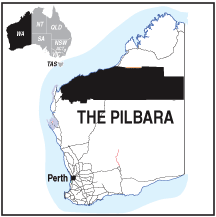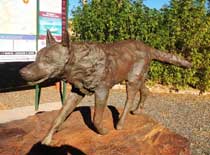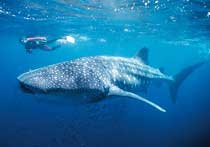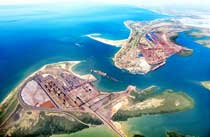 |
| Pilbara Region
WA |
Population: Area- 48,500
Total Area: 502,000 sq. km.
Latitude: 21.2900,
Longitude: 118.0200
Location: North of Perth on the coast
Highway: North West Coastal Hwy
Nearest Major Town: Area north of Perth
Nearest Airport: Port Hedland
Touring Area: WA - Pilbara |
|
An area of northern Western Australia |

Statue of 'Red Dog' in Dampier

Swim with Whale Sharks on Ningaloo Reef near Exmouth

View over Port Hedland
|


©
Copyright Peter W. Wilkins |
|
|
THE PILBARA REGION IN THE NORTH OF WESTERN AUSTRALIA
The rugged and scenic Pilbara is a popular adventure holiday destination, some 1,300 kilometres north of Perth,
containing three world class national parks, including the Rudall River and Karijini parks - considered among
Australia's most stunning natural assets.
The Karijini National Park, in the rich ore fields of the area near Tom Price, has secluded rock pools and
clear waterfalls set amongst stark deep red gorges.The stunning Fortescue Falls, where two waterfalls cascade into
Fern Pool - a permanent swimming hole surrounded by lush vegetation, is a must to visit.
The Rudall River National Park is reached by four-wheel drive from Newman on the Great Northern Highway where you
can take a tag-along tour of the single largest open-cut iron ore mine in the world and discover ancient Australian
aboriginal art.
The more adventurous can join the rugged 4WD Canning Stock Route for a taste of outback driving along one of the
most famous cattle drive routes in Australia. It is little more than a dirt track between Halls Creek in the east and
Wiluna in the south, a distance of 1,850 km along the world's longest stock route and traversing 3 deserts. It is not
to be taken lightly and detailed advice should be obtained before attempting it.
Less challenging is the route from Newman to Port Hedland via Marble Bar, Australia's hottest town, with majestic
architecture and warm hospitality. Marble Bar set a world record of most consecutive days of maximum temperatures
of 37.8°C (100°F) or more, over 160 days from 31 October 1923 to 7 April 1924.
Inland to the west are the unique communities of the rugged outback, including Tom Price, the highest town in Western
Australia.
Most of Australia's iron ore is mined in the Pilbara, with mines mostly centred around Tom Price and Newman.
The industry employs 9,000 people in the Pilbara area, many of them are 'Fly-in - Fly-Out' employees
living elsewhere in the country and commuting. The Pilbara also has one of the world's major
manganese mines, Woodie Woodie, situated 400 kilometres south east of Port Hedland.
Iron ore reserves were first discovered by the late Lang Hancock, and much of the Pilbara is still claimed by
his daughter Gina Rinehart and the family company Hancock Prospecting. Blue asbestos was first mined in
Wittenoom Gorge in 1943 but has since ceased due to health concerns and the town is closed.
In the 1960s, the area was described as 'one of the most massive ore bodies in the world' by then
vice president of US-based steel company Kaiser Steel, Thomas Price who lends his name to one of the
mining towns in the region. It has been estimated the amount of ore here is 24 gigatonnes, or 24 billion
tonnes and the Australian Bureau of Agricultural and Resource Economics in 2010 estimated the resource is
being retrieved at 324 million tonnes a year. With growth over coming years the resource is predicted to be
gone within 30 to 50 years.
With a 2.5 billion year old landscape, the Pilbara has some outstanding indigenous art and an
ancient culture with over 700 historic indigenous archaeological sites and 10,000 rock engravings (petroglyphs), many
dating back some 30,000 years.
The Burrup Peninsula north of Dampier, is heritage listed and an ideal place to explore the unique art, history
and culture of the indigenous peoples of the Pilbara. It has the world's largest collection of outdoor rock
engravings, even some of the now extinct Tasmanian Tiger.
The Millstream-Chichester National Park is south of Dampier on the picturesque Fortescue River. Surrounded by
waterlilies, ferns and the rare Millstream Palm, it's ochre earth is decorated with wildflowers during winter.
Exploring the Pilbara Coast
For fishing and diving adventures, head for one of the many coastal towns such as Karratha and join a boat trip
to the Buccaneer Archipelago or Rowley Shoals Islands.
Sheltered bays along the Dampier coast cradle clean, empty beaches leading into cool coral grounds for snorkelling
at its best. At certain times of year, you'll spot turtles lumbering up the beach to lay their eggs, or migrating
humpback whales.
The Pilbara also offers a range of accommodation choices, which include hotels, lodges, backpackers' and caravan
facilities. Use the accommodation search opposite to find a few.
Karratha is the gateway to the Pilbara. The pretty port town of Dampier sits just 20
kilometres to the west and the mining town of Port Hedland to the east. Proclaimed in 1866, Roebourne is the
oldest settlement in the North West. Visit the heritage listed Old Roebourne Gaol, home to the visitor centre and
historical museum. Cossack is a ghost town and has many beautifully restored historical buildings which offer an
insight to the hardships and successes of the first settlers.
EXMOUTH AND NINGALOO REEF: Swimming with whale sharks.
Ningaloo Reef is located off the north west coast of Western Australia, approximately 1,200 km
north of Perth and around 260 km long. It is Australia's largest fringing coral reef and the only large reef
positioned very close to a landmass, being less than half a kilometre offshore in some areas, such as Coral Bay.
Although most famed for its whale sharks which feed there during March to June, it is also rich in coral
and other marine life and part of the migratory routes for dolphins, dugongs,
manta rays and humpback whales.
The sandy beaches are an important breeding ground of the loggerhead,
green and hawksbill turtles which depend on the reef for nesting and food. The Ningaloo supports an abundance
of fish (500 species), corals (300 species), molluscs (600 species) and many other marine invertebrates.
The reef and surrounding waters were designated as the Ningaloo Marine Park in 1987 due to its unique properties and in 2011
was world heritage listed by the United Nations.
Whale Shark (Rhincodon Typus)
This fish, the largest of the shark family and the largest fish in the world, is a harmless plankton eater. Reported
to reach 18 metres (60ft) but averaging 12 metres (40ft) in length, it is easily identified by its huge
size, wide mouth and is monitored by its distinctive skin patterns of white spots.
Thought to mainly inhabit worldwide temperate and tropical seas, it is rarely seen in shallow coastal waters, but
is a daily visitor to the Ningaloo Reef every year between late March to July when up to 30 have been spotted close
to the reef feeding on the plankton in the nutrient rich waters.
You can experience an unique ocean experience from late March to July each year by swimming with the largest fish in
the ocean.
The Exmouth Diving Centre
can take you on a sensational day of adventure that you will never forget.
If you can swim and snorkel, you can safely experience the excitement and wonder of swimming with the world's
largest fish. If you can't snorkel, the staff can teach you.
TOURS
Tours operate daily from late March to July. (Prices at 7/3/14) Go to website for current prices.
Snorkellers only: $385, Children under 16: $245 , Observer: $240 , Family 2 adults-2 children : $1,200
DAMPIER & KARRATHA: Home of 'Red Dog'
The port of Dampier was built from 1965 to handle shipments of iron ore from Mt Tom Price via a specially built railway.
It takes its name from the archipelago just north which comprises a peninsula and some 40 islands and is of
significant cultural importance.
Dampier takes its name from explorer William Dampier (1651-1715) who visited the
area in on the 'HMS Roebuck' in August 1699.
By 1968 Dampier had reached its development limits and a new town, Karratha, was established nearby and is now the major
centre for the area.
The Dampier Archipelago and Mackerel Islands lie just off the coast offering world-class
boating, fishing, diving and snorkelling. Important turtle hatcheries can be seen between September
and April when female turtles lay their eggs in the sand dunes and newly hatched babies scramble to the ocean.
At the entrance to the town is a statue of "Red Dog", a red kelpie/cattledog well known for roaming the area in
the 1970s and hitching rides to nearby towns. The plaque reads 'Erected by the many friends made during his
travels'. Other attractions include the fishing for reef fish, barramundi and mud crabs.
On 3 October 1952, the British conducted their first atomic bomb tests on the Montebello Islands off the coast as
part of Operation Hurricane.
|
|



